Mirror lenses, which are also known as ‘catdiotropic’ or ‘reflective,’ were all the rage in the ’70’s, and 80’s but dropped out of favour in the ’90’s . In the digital age do they have a purpose? This article tests several mirror lenses from different manufacturers, explains the advantages and disadvantages compared to conventional (refractive) lenses and shows how most of the disadvantages can be overcome in the digital darkroom. There are plenty of test pictures throughout and sample images taken in the years since I carried out the test all available in a Flickr album at up to full size.
Up until around 6 years ago, Tamron, Nikon, Zeiss and Minolta all still had mirror lenses in production. Now of the big brands only Sony have one available, and this is the previous Minolta model rebranded. There are some other cheaper makes such as Kenko, Vivitar and Centon new. There are plenty of lenses to choose from on ebay, and I bought 4 of them to evaluate, eventually selling all but one.
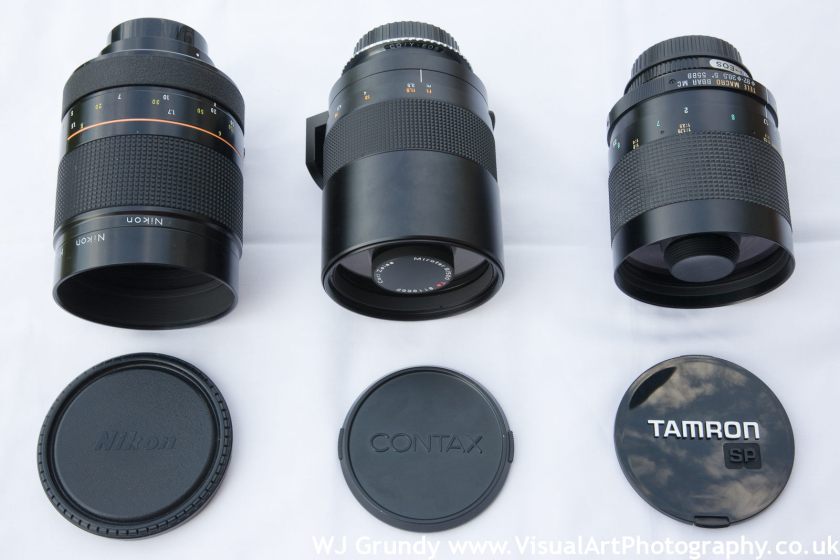
For some reason I really like the retro graphics on the Tamron lenses!
Why a mirror lens?
Mirror lenses are telephoto lenses that use a combination of two mirrors to reflect light back and forth between the ends of the lens prior to the light passing through to the camera. (See diagram) This means that the physical size of the lens is around a third of the size of a conventional lens and the mirrors are also much lighter than the optical glass.
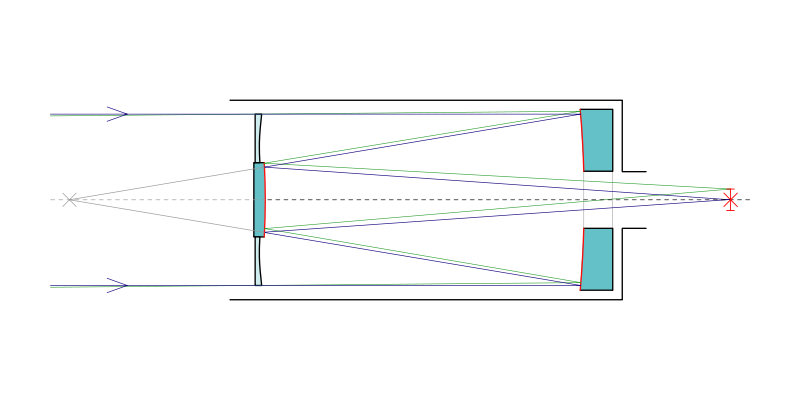
The small physical size and weight of the Mirror lens means that it is possible to hand hold with an appropriately fast shutter speed and of course the lens does not look like a paparazzi tool, so it is discrete. It is also far more likely that you’ll be carrying a mirror lens, it is unlikely that you’ll pack a 500mm F4 refractive lens for a walk about town! Chromatic aberration is virtually absent by design.
Mirrors are significantly cheaper than conventional long telephotos, starting at around £100 for a cheap brand up to £2000 for the best manufacturers, with the better independents available second hand on ebay for £150.
Mirror lenses have no mechanical or electronic link with the camera body as their is no variable iris, so it is possible to fit almost any mirror to almost any SLR with an appropriate adaptor. For my Canon 5D, I was able to obtain adaptors for Contax/Zeiss, Nikon, Pentax K and Tamron.

The disadvantages
It was all sounding too good to be true – so here is a list of the disadvantages.
The aperture and focal length is fixed – the most common versions are 500mm f8, 350mm 5.6.
The fixed aperture means there is no control over depth of field. At these focal lengths and apertures, the depth of field is very small, making these images most suitable for objects that are at the same distance. For example the side of a building face on is fine, but shooting that same building at an angle will result in a visible plane of focus with everything else in front and behind blurred. Unfortunately the out of focus parts of the image (bokeh) can look messy and distracting with out of focus highlights turning into rings of light – or doughnuts – a mirror lens characteristic which can be attractive when used appropriately.
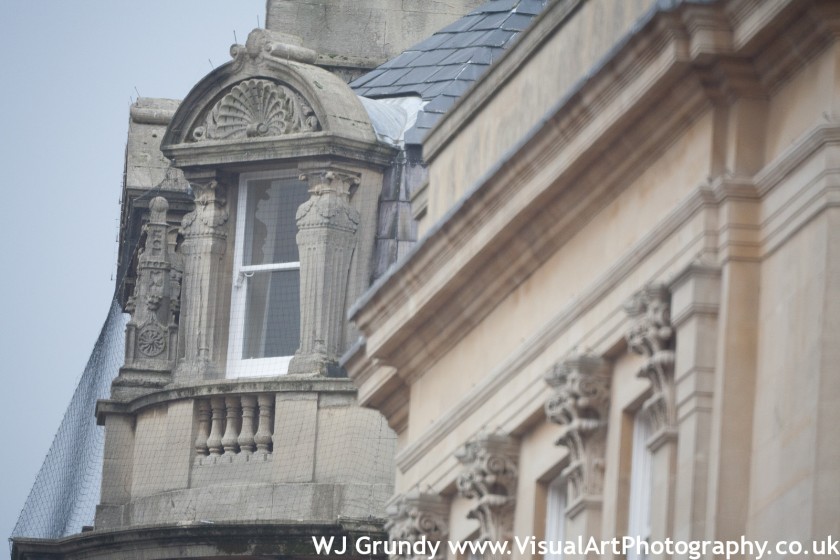

The images from all these lenses tend to have bright centre with dark corners – Vignetting, or even a marked “hotspot” in the centre. The Nikon was the worst, however easy to fix using the vignette tool in Lightroom, I used +55 midpoint 12 to fix the Nikon.
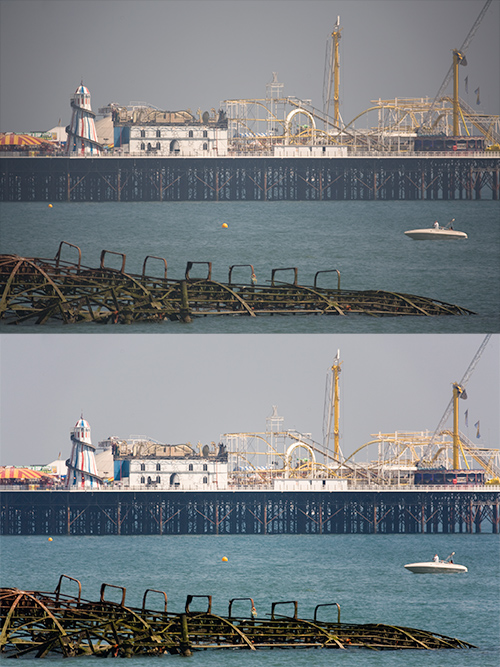
All the mirror lenses apart from the Sony (Minolta) 500mm f8 are manual focus and it can be tricky to focus a 500mm f8 as the viewfinder is quite dark. The Sony AF Mirror is very light and takes advantage of the in-camera Image Stabilisation, making it possible to handhold, even on a crop sensor body like the A700 – in this case giving 750mm effective focal length. The autofocus certainly makes life easier, although it does have a tendency to “hunt” which given the small aperture (f8) is not surprising.
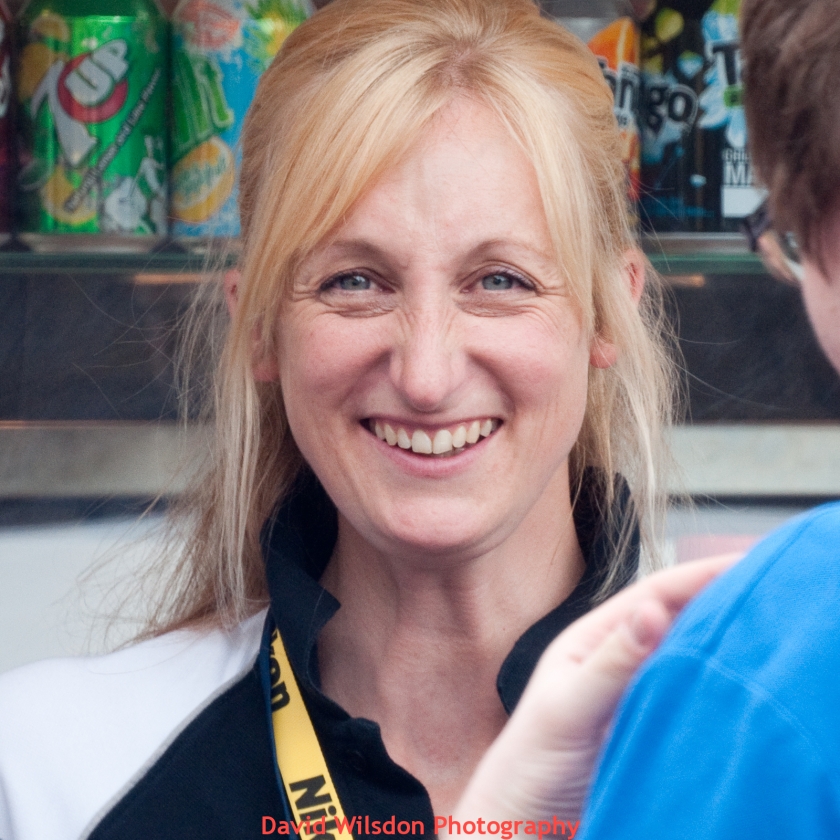
Exposure problems. In the days of film these problems lead to the downfall of the “Cat” lenses. The fixed aperture and of course fixed ISO for a particular roll of film meant that shutter speed was the only variable, albeit a very inconvenient neutral density filter (fitted to the back of the lens) could reduce the amount of light. The shutter speed needed to be fast (above 1/500th second) to avoid camera shake, so the conditions in which a successful shot would result were limited.
How digital can mitigate these faults (to a degree)
The combination of shooting digitally and simple corrections in software like Lightroom in post processing enables some of these disadvantages to be overcome, to a degree where it is once again worth thinking about adding one to your collection.
Exposure – with a digital SLR the ISO is variable, so the photographer can use ISO to ensure a fast enough shutter speed.
Vignetting is easy to remove – as long as RAW images are used, the RAW converters have a simple slider to remove this- better still this is consistent from one picture to another, so once the position of the slider is determined all the other images can be corrected in seconds. (Doing this to JPEGS will significantly degrade image quality as there is so little data in the shadows, that there will be a considerable increase in noise)
Manual focus is probably the biggest disadvantage to overcome as the depth of field for a 500mm lens at f8 is very small – and of course smaller with subjects that are physically closer.

Modern autofocus SLR’s also don’t help you to manual focus as there is no aid on the focussing screen. There are two ways around this. For owners of expensive DSLR’s eg Canon 1 series, the centre focus point will light up when the image is in focus, so the photographer can turn the focus ring until the light comes on and be assured of sharp focus. Sony Alpha users can choose the autofocus 500mm f8. For the rest of us we just have to be really careful with manually focussing, I often bracket focus, taking several shots with slightly different settings hoping that one will be right. Modern DSLR’s with live view can be used to aid focussing, simply zoom in electronically to precisely focus. This has proved successful when using the mirror lenses on the Canon 5dmk2. However this is quite time consuming and certainly not of use for fast moving objects.
Bokeh is also a tricky issue. It becomes more critical with a mirror lens to choose a plain background for the subject. When this is not possible – digital manipulation could be needed to edit anything particularly distracting.
In summary for the digital photographer it is a balance between,
| For | Light weight and physical size, discrete, cheap |
|---|---|
| Against | Manual focus, small depth of field poor bokeh, slow to use |
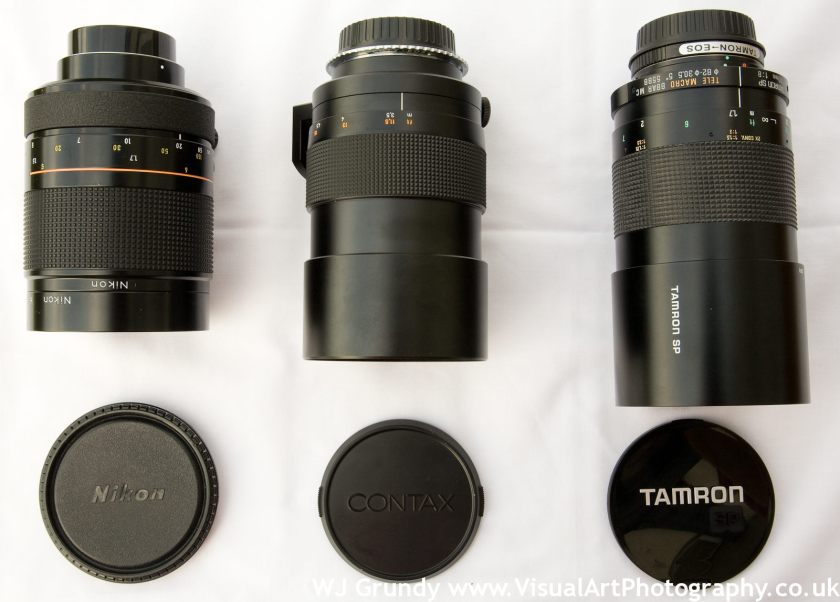
The lenses Tested at a glance.
All the lenses were tested using a Canon 5D full frame DSLR – at the time one of the hardest tests for any lens. The 5D suffers from vignetting so the Mirror lenses would exaggerate this. Subsequently I have taken some shots with my 5D mk2, but only with the lens I kept. Note that it is quite straightforward to fit any of these lenses to a Canon EOS full frame as they do not have variable aperture, and thus require no electronic communication to the body. It is therefore just a physical fit required. Some enterprising folks o nubby have realised how hard these lenses are to focus manually so are creating “Focus Confirm Adaptors” – These have contacts and a programmable chip built in that enable the focus confirm lights in the 5D range to illuminate when the image is in focus. I have now also tested the Zeiss with the Canon 5Dk3 using a Focus Confirm adaptor.
| Manufacturer | Length | Aperture | Price new | Price USED | Adaptor |
|---|---|---|---|---|---|
| Nikon | 500mm | f8 | £1000 | £200 | £15 |
| Tamron | 500mm | f8 | £400 | £150 | £30 |
| Carl Zeiss / Contax | 500mm | f8 | £2000 | £1000 | £25 |
| Tamron | 350mm | f5.6 | £300 | £170 | £30 |

Nikon 500mm F8.
This was the third and final version of the Nikon 500mm f8., identified by it’s orange stripe, it focuses more closely than the older versions. Introduced in 1983 its predecessor was in production for 25+ years.
Build quality is very high, smooth focussing mechanism, solid case and integrated tripod bush. The built in non-adjustable hood is perhaps to short, while adding to the physical size of the lens. This came with a fake leather case with space for filters underneath the lid. This really felt like a high quality expensive product.
Slideshow of sample images from the Nikon
Tamron 500mm f8
This cult product was one of the best selling mirrors and with good reason. There were a number of different “Adaptal 2” lens mounts to choose from making it possible to fit it to most SLR’s. The build is good – though it doesn’t feel as robust as the Nikon. The silver evaporated mirrors were much heralded at the time. The lens hood is separate and must be screwed in. When not in use it can be reversed and placed over the body of he lens but doesn’t stay attached which is annoying. There was a matching 2x teleconverter made by Tamron, – this wasn’t tested. There is no integrated tripod bush – indeed it is not possible to fit the lens on a tripod at all. Instead Tamron provide a circular extender plate to screw onto the camera body. This has a tripod bush underneath and enables the camera to be fitted to the tripod with the lens attached – the lens would be too fat without it. The lens is so small and light that I didn’t feel this was a disadvantage, however it lacks the ability to turn the camera between portrait and landscape on the tripod ring in the way that all the other lenses here can do. The Tamron came with an attractive oblong fake leather case, with space inside for tripod bush and filters.
n.b. Due to a copyright infringement lawsuit brought by Canon, Tamron had to stop production of the EOS mount for the Adaptal and SP ranges of lenses, so an EOS Canon mount became as rare as hens teeth until some enterprising Chinese manufacturers starting making mounts and selling them via ebay.
Sample Images Tamron 500mm f8
Tamron 350mm f5.6.
This rare lens was well regarded at the time, it’s focal length makes it particularly of use for SLR’s with an APS-C sized sensor, giving an effective 525mm on Nikon, or 560mm on a Canon. Unlike the Tamron 500mm, this lens has an integrated tripod bush that allows easy movement from portrait to landscape. The screw on hood reverses over the lens for storage, but again is loose.
Contax Zeiss Mirotar 500 f8.
This lens is only available in Contax / Yashica mount, but adaptors are readily available on ebay for most cameras. Zeiss have a great deal of experience making mirror lenses for telescopes. This is quite a rare lens, unlikely to find this on ebay, but still available new in the UK from ffordes in Scotland, who bought up all the stocks from Contax when they stopped production. This is the ‘Rolls Royce’ of the mirror lenses here, beautifully made with smooth focus action and precision fitting sliding lens hood and revolving tripod bush.
Other lenses
Centon 500mm f8 approx £100 plus T2 mount
I bought one of these new from Jessops a few years ago, and shot a whole roll of film, with Canon A1 on a tripod, I was really careful with focussing, using bracketing etc. I didn’t get one single sharp image, so I returned it for a refund. This lens is just a piece of junk!
The Sigma 600mm.
There appears to have been two versions of this, the standard black one and a green one. I tried the black version in a shop in Bath, I took a few pictures with it. The images were of extremely low contrast and quality. I decided not to part with the £150 for this. Tests at the time by Amateur photographer were not complimentary about this lens either – it was consistently outperformed by the Tamron 500mm, regarded as the best independent of its day. I have subsequently bought one and found that it is capable of good results on the 5D mk3. While I didn’t include it in this comparison (as I didn’t own it at the same time as the others here) I will upload some results and test it separately.
The photographic tests
I found suitable locations and used a tripod, switching lenses and noting on paper the shots that corresponded to each lens. Note that these lenses have no electrical connection, so no aperture date or distance is provided to the camera. As focusing is so tricky with these lenses I took several images, bracketing focus and have chosen the best example from each lens.
Image1. House on the hill.
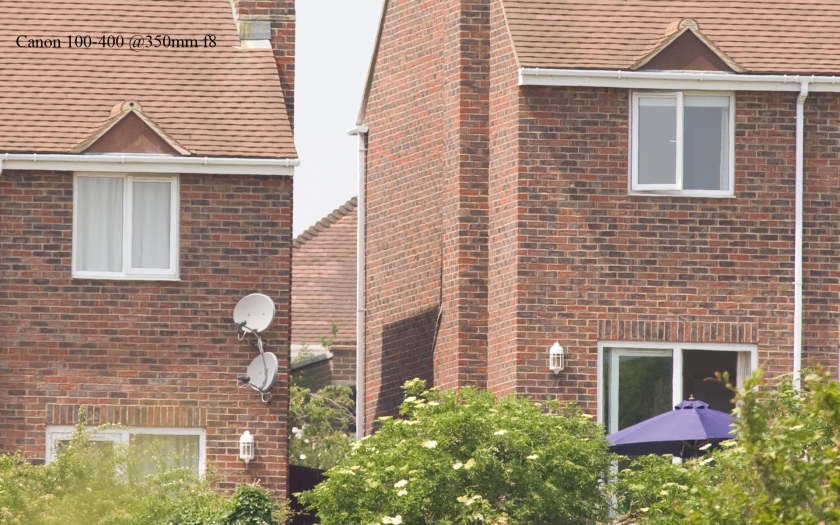
Image 2. Buildings on Brighton seafront click for 100% Crops

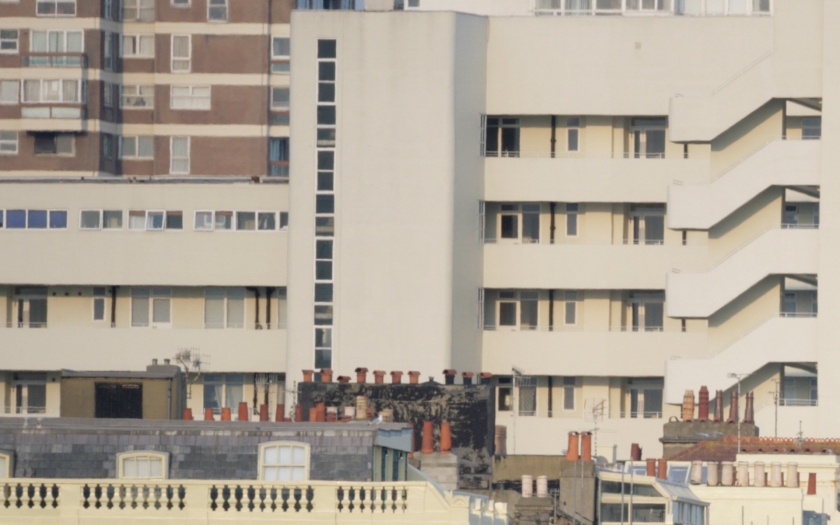
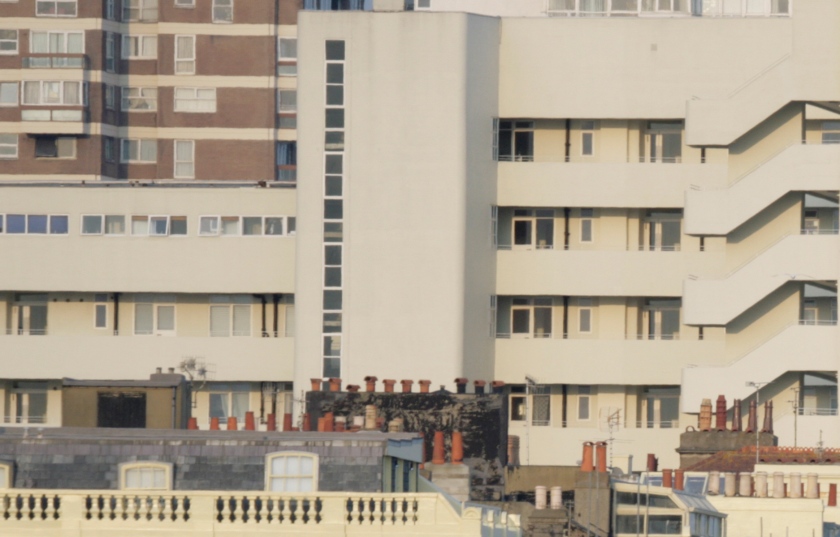
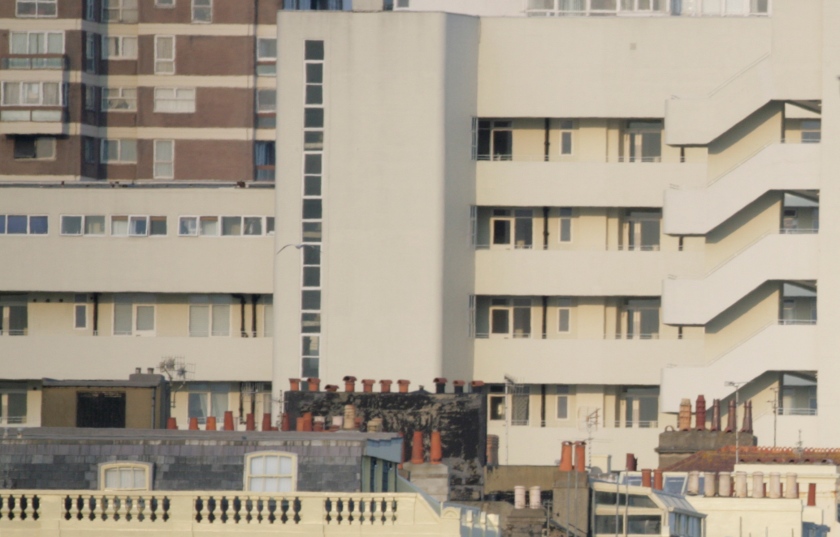
These images were taken from Hove Lawns, with a tripod. I shot several of each with different focus points. I focussed on the white steps. The Carl Zeiss is clearly sharpest, followed by the Tamron and Nikon.
Walkabout images.
A few observations and tips for getting the best results
I went out on numerous occasions and used each of the lenses to see what sort of images I could get. The lens is inconspicuous, so you don’t get the sort of attention that you would with a paparazzi lens. Distance subjects work better than close ups. The Tamron 500m is the best at close ups, but the usefulness of this is reduced by the universally achieved poor background blur, so careful selection of backgrounds is essential. Nearly out of focus areas look distracting. These lenses work much better with objects that are at the same focus distance with nothing in the foreground or background.
Taking people pictures.

I managed to get some good images of people, including managing to get the out of focus doughnut highlights, which I rather liked in this context. In the 70’s magazines often had portraits shot against the sun on sea to achieve this effect.
The tiny depth of field helps – if the people are standing up, but I found that the limited depth of field means that their face could be in focus, but other parts of the body blurred.
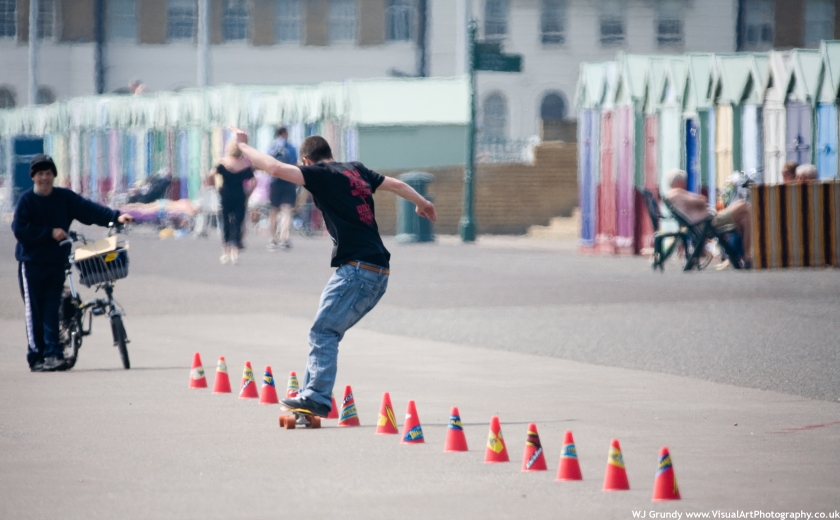
Action
Moving objects are trickier, requiring pre-planning of where the moving object is travelling to and focussing in advance. This technique was used for the skateboarder, I focused on a cone ahead of the subject and waited for him to move into the plane of focus.Trying to focus and pan at the same time is very difficult.
Action pics
Overall ratings
| Lens | Handling | Sharpness | Vignetting | Build | Value | Total |
| Nikon | 4 | 3 | 1 | 5 | 2 | 15 |
| Tamron 500 |
2 | 4 | 2 | 3 | 5 | 16 |
| Carl Zeiss / Contax | 5 | 5 | 4 | 5 | 4 | 23 |
| Tamron 350 |
3 | 1 | 2 | 3 | 2 | 11 |
Handling
The smooth focussing action, integrated hood, and excellent tripod bush win this for the Zeiss. The Tamron 350 gets the nod over the 500mm because of the integrated tripod bush.
Image quality – Sharpness and Vignetting.
The Zeiss has the least vignetting effect, has the best contrast and is the sharpest. The Tamron better than any of the others closeup. The Nikon has a characteristic central hotspot, and is no sharper than the Tamron 500mm.
The Tamrons 350 is soft and suffers especially from low contrast and vignetting, I really struggled to obtain a sharp image from this optic.
Value for money
My Favourite without doubt is the Contax Zeiss Mirotar, the best handing, build and image quality, (and the one I decided to keep). I would certainly have not have paid £2000 for one as a modern Canon L or high end Sigma for that price would be more versatile (but bigger) at £1000 used however, and subsequently testing it on the 5D mk3 with focus confirm adaptor – it is the lens to buy now as it’s improved sharpness over the other lenses here mean that it better makes use of the higher resolution modern cameras. The Tamron 500mm was available for £400, it is closer in image quality than you might expect (on the 12MP 5D) and is the overall Best Buy in this test – unless you have a 20MP+ camera). Now available for under £200 used with mounts that fit a whole range of DSLR’s this is the lens to look for to see how it is “all done with mirrors”. The Nikon is poor considering it cost £1000 new. The build quality is high but the image quality didn’t match up. The Tamron 350mm is rare and thus expensive, frankly I wouldn’t bother with it, it was the first one I sold, and it is easy to get to 350mm with a conventional lens. Close up images 20 feet away! were especially soft.
Overall
The Mirror lens is not a replacement for a high end 500mm lens like those from Nikon or Canon, but you are much more likely to find yourself out and about with one. These refractive lenses cost thousands of pounds and weigh several Kilos. The mirror lens gives you a low cost route to large magnification, as powerful as a pair of 10×50 binoculars they will give you a different perspective, and maybe some interesting images, but overall I found them fun to use. When buying second hand, be sure to look into the lens and check that there is no mould growing in the mirrors. All the lenses I tested were flawless.
My recommendation is to find a low cost Tamron 500m f8 for around £150-200 and have some fun, or if you can afford it £1000 for the Zeiss will get you the best 500mm mirror lens ever made! If you are a Sony Alpha user, you can buy the only autofocus mirror lens available, though I have taken some pictures with it and from my short experience with it I’d say it is certainly worth a try.
You have probably guessed, I kept the Zeiss, see examples that I have taken with it here.
Now see PART 2 of this test – updatedin 2016
Mirror! Mirror! -a guide to choosing and using Mirror lenses part two
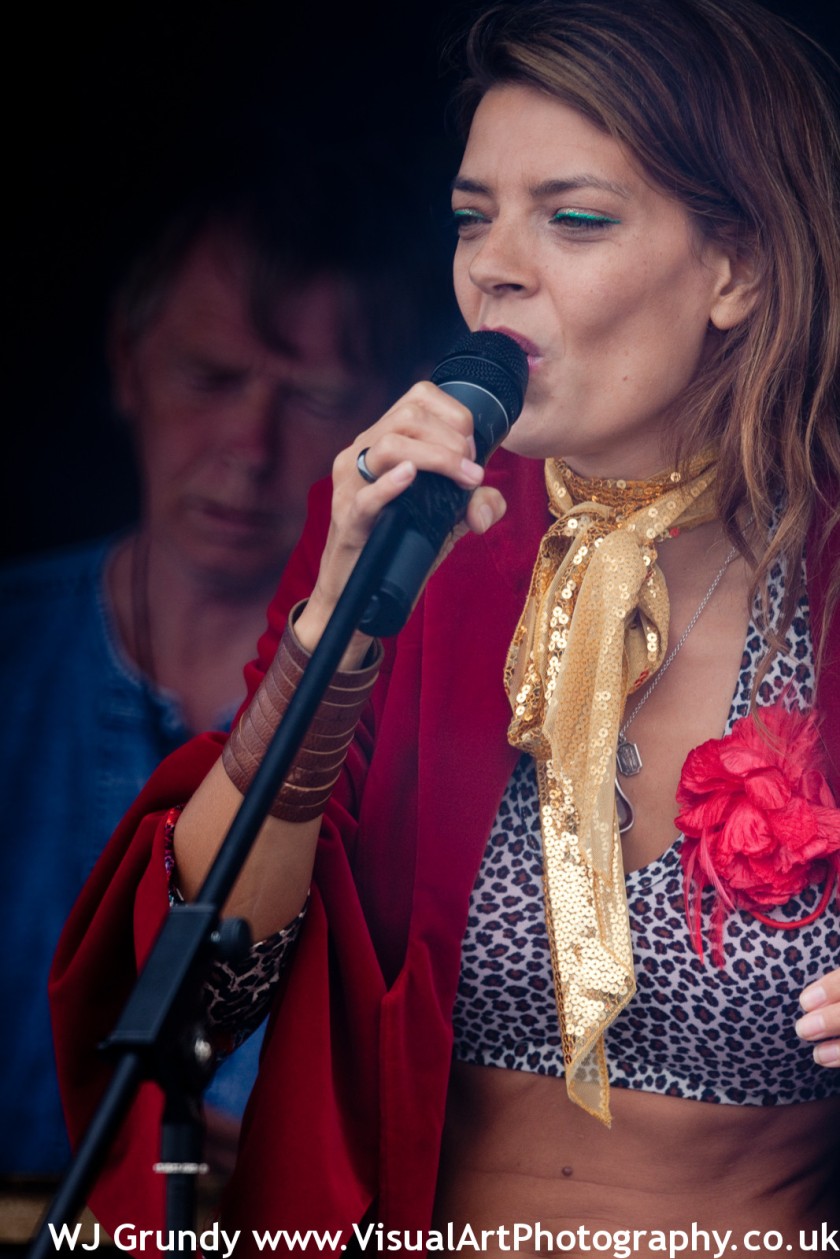
Notes and links
Zeiss Mirotar 500mm on Canon EOS 5D mk3 with Focus confirm adaptor.
The 500mm f8 Reflex Group on Flickr – some great shots!
The Reflex lens Group on Flickr
The development history of the Nikon 500mm lens is really quite interesting and can be seen here.
Zeiss have a technical paper on the design of the Mirotar.
Bob Atkins has compared the Tamron 500mm 8 to a Canon 500 f4.5 – it makes interesting reading.
Test of the Sony 500mm f8 with Autofocus.



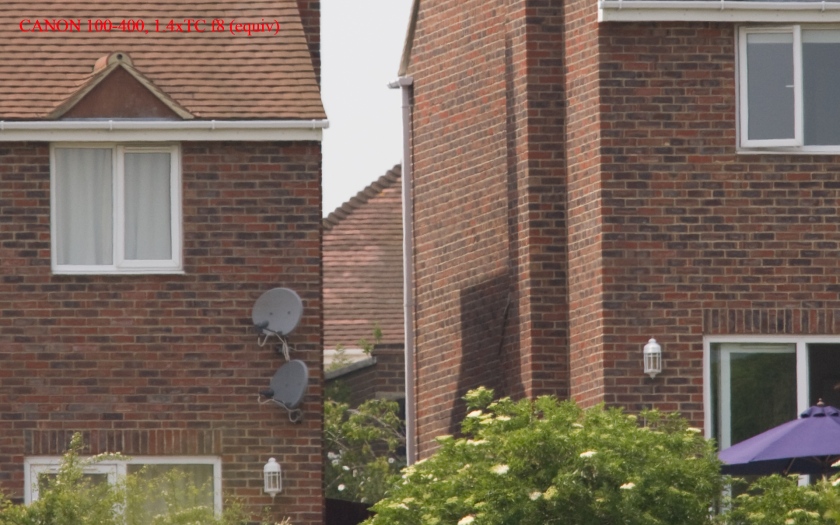


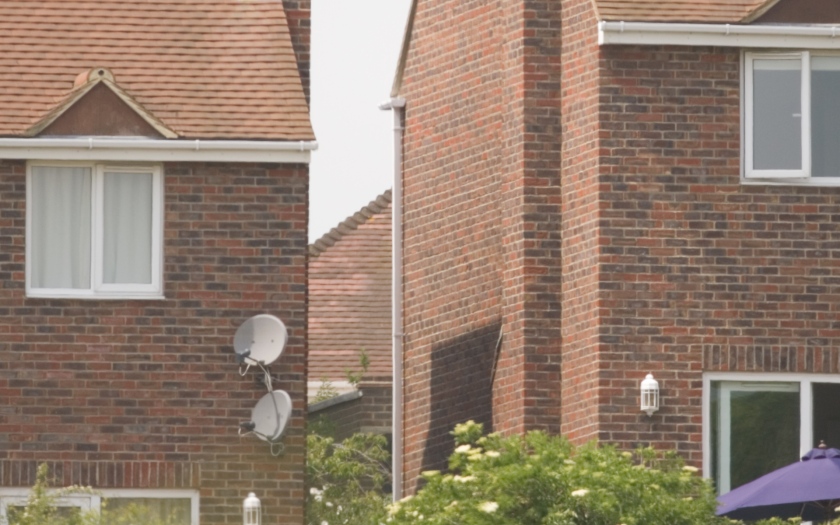

Its like you read my mind! You seem to understand a lot about this, such as you wrote the e-book in it or something. I believe that you simply could do with some % to drive the message house a little bit, however other than that, this is wonderful blog. An excellent read. I will certainly be back.
Dear sir,
This is a very interesting site.
I have a Nikon D5100, and I want to buy a Tamron 500 mm F8 mirror. Do you know where I can buy an adapter for Nikon and will my camera work with it ?
Thank you very much for your reply,
Francis
Belgium
You can get a whole host of adapters on ebay, from Chinese companies.
eg. http://www.ebay.co.uk/itm/Tamron-Adaptal-AD2-Nikon-N-AI-Mount-Adapter-cap-NAI-/350519065198?pt=UK_Photography_CameraLenses_Lens_caps_hoods_adaptors_ET&hash=item519c907a6e
Can anyone help my centon 500 mirror lens is great to focus on my nikon 5100 but the photo is realy dark.it looks great through the view finger.but the photo is black
Sounds like the Nikon is not metering. Are you using Manual exposure? I believe some Nikons will not automatically meter when using a lens with no electronic communication to the body.
I bought the Nikon you were talking about. Aside from the inherent downsides, it seems to be a very sharp lens. And I use it on my D800 with auto-iso at 640 shutter speed and the only thing I have to worry about is manual focus and which metering mode to select. On a lesser camera like a d90, it is a pain in the arse.
That”s interesting the D800 is indeed a stern test of lenses!
Thank you for the article, it is helpful. I would like to use one of these lenses with my OM-D M-5 Oly MFT camera. I want a sharp lens but I also want to save $$. Looks like the Nikon might work. Do you have an opinion on this application?
If you can get he adaptor it should work fine.
Thi sis something to try to test – if you can get an adapter. But you may also look at this…
Tokina Mirror designed for MicroFour Thirds
http://www.amazon.co.uk/Tokina-REFLEX-F6-3-Manual-Focus/dp/B00828DZ7M
I don’t have a micro 4/3 camera and the lens will not fit a FF. I’d be interested to hear views of others that have tried it.
I own a 500 F-8 lens made by H Q Optics (made in Korea),which I received in a horse trade many years ago.I have only recently gone digital,and I have only use it once on my Canon T-3,but I am not a pro,and I just couldn’t see letting it go with all my 35mm stuff. When I used it on my Pentax M E Super,it seemed to work just fine.I intend to use it more on digital,knowing it will take time to shoot.I have just leaned against a tree or pole to keep from using a tripod,but I do have a good Slik when necessary. If you are not a pro,this lens works just fine.
Great write-up, thanks for posting this. I love the comparison shots that you did!
Hi
I have a Sigma 600mm/f8 mirror lens I bought new in the late 80’s to use with my Canon AE1 so it came with the Canon adapter. Can I get an adapter for my Nikon D90 and D7000? I have heard that it may affect the mirror movement in these cameras. Is this true? Where would I check in Nova Scotia, Canada? If available what is the approximate cost?
Thank you
Sorry I have not tried this, though I have tried the Sigma on my Canon 5D mk3 and am impressed with it, test soon to appear.
Anyone else able to help?
I am considering getting a 500mm Mirror lenses. For the Sole purpose of Lunar and Astral photography. Size and weight is not a concern since i have a tripod i would use with it anyway. My camera body is a µ4/3 & Currently my lens I am using for these kinds of shots is a Minolta MD 100-300mm Zoom lens with the Minolta 300s 2x teleconverter. The 300mm is the longest i have , and at 300mm alone the moon is too small and soft when I also have to crop heavily. with the 2x converter its fine but soft and i need to sharpen alot in PP.
DO you still recommend the Tamron for me or should i look for something else?
A 500mm f8 will give you effectively 1000mm or 20x magnification on a micro 4/3
Or you could look at a telescope and adapter?
hi l am a astrophotograper an l wont try use a 500mm mirror lens whats the best
The Zeiss 500mm f8 Mirotar – they make astronomical telescopes using the same principle. Or buy a telescope and get a DSLR adaptor.
Bit surprised that the results for the tamron 350mm weren’t so great I wonder if yours was a below average example. Mine is sharper than my 500mm f8 IMO.
I think you could be right. Lenses are variable in quality due to tolerances during manufacture – I tried 5 Canon 24-70L k1’s before I found one that was equally sharp in all four corners. These lenses are also 20 years old so who knows what they have been through. The AP test at the time showed that the Tamron 350 was better than the Tamron 500 which was better than the Sigma 600mm – but that is not what I have found in testing so sample variability has to be a factor.
Hmmm … well the Zeiss @£500-800 makes the contest a bit unfair with the vast price difference the OPTEKA 500MM would’ve been a better replacement for the test … you’d expect the Zeiss to be the best by a long shot for the cost and this test clearly shows it’s not worth the extra 100’s of pounds … it also shows the Zeiss is definitely not ‘that’ much sharper than the other 2 (imho) … it should be far more superior for the money … I think any person wanting a 500mm f8 should go with the Tamron SP (I have one on my 550D) with its price range around £50-150 … I would be miffed if I spent £500-800 on the Zeiss and only produced ‘similar’ results to the others …
My 2 pence worth 😉 …
Love the post though … thanks …
Isn’t that what I concluded? But I still kept the Zeiss. It is sharper, has a built in hood, rather than an inconvenient screw on affair, and it does produce sharper images, particularly with the new focus confirm adapter – see later post.
Stumbled across this page today whilst updating my own 2009 Vivitar 500mm review Wayne. Great read. I’ve since adjusted the article to reflect lower new prices and that some f/8 versions seem to be discontinued. I would be wary of the cheap T-Mounts and buy at least German or English brands (may well be made in China but with better specs/QC). How have results been on newer 2012-2015 DLSR sensors and what DSLR did you use to take the sample shots in your review?
I have linked your URL in my updated review: http://bit.ly/tyEu5L
Regards Harvey
I used the 5Dk2 and more recently the 5D mk3 for the Zeiss and focus confirm adapter tests.
Thank you–recently bought new Samyang pro 6.3 500mm and so far my experience much as you say. Don”t be to serious and enjoy the fun. The Samyang is excellent no hot spots or vig. very sharp but getting in focus a pig.As you say take several shots and hope some are in focus.
bracket focusing is a good idea with any mirror lens.
lenses have no mechanical or electronic link with the camera body as their is no variable iris, so it is possible to fit almost any mirror to almost any SLR … llensesc.wordpress.com
Yes, in principle though depending on the specifics of the mount, there may be a problem getting infinity focus. For example fitting the Canon FD 500mm f8 to an EOS body will be a problem unless the mount adapter has optics to correct this. (Due to back focus distance) Some camera bodies, notably older Nikon DSLR’s won’t function with an unknown mount on the front. Some camera bodies like the Sony A7 make it easy to fit different manufacturers lenses.
Long distance astrophotography = Oly Pen E-PL1 w/ MTO 1958 Russian mirror @ F:10, using m39>m4/3 rds adapter. Exposure in S mode, Iso 160 w/ 2 sec. delay. 2000mm equal w/ crop factor, not bad for the cheap investment. of camera body and lens.
Thanks a lot for this review, I enjoyed it a lot. There is one problem though, I believe that you have a ‘lemon’ Tamron 350/5.6 MR-SP. I have both the Tamron 500/8.0 MR-SP and the 350/5.6 MR-SP. The image quality I get from them is extremely similar. Good but with one issues – lack of contrast. And of course ‘donuts’ bokeh. They are also, like all mirror lens, very difficult to focus optimally. Problem is, it doesn’t match your assessment of sharpness. And think about it: these two Tamron lenses are using very similar optical schemes, are the same size, and were made by the same company at the same time. I am convinced that it is a bad sample issue.
You could be right Yves, I had to source these lenses used and are of course quite old now. I tried a few Sigma 600mm mirrors before I found one good enough to test. The reviews at the time said hat the Tamron 350mm was good. However 350mm is easily covered by modern lenses, (e.g.g Canon 100-400) and will still not possess the resolution required of modern cameras like the Canon 5Dmk4.
Shvabe (russian firm) launching a new set of revised mirrored lenses. They’re the ones that own the Rubinar brand…
https://camnostic.com/2021/02/russian-firm-launching-fat-mirror-lens-lineup/